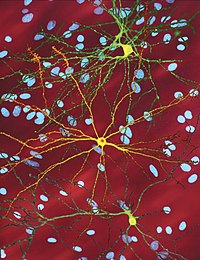
Photo from wikipedia
BACKGROUND To increase the reliability of translating preclinical findings to humans, large animal models, such as the transgenic (tg) Libechov minipig, were established. As minipigs possess high genetic homology with… Click to show full abstract
BACKGROUND To increase the reliability of translating preclinical findings to humans, large animal models, such as the transgenic (tg) Libechov minipig, were established. As minipigs possess high genetic homology with humans and have similarities in anatomy, physiology and metabolism to humans, they are considered for studying neurodegenerative diseases longitudinally. Recently, sleep abnormalities and changes in circadian rhythm in Huntington's disease (HD) patients were acknowledged to present one of the early symptoms in HD. OBJECTIVE The aim of the present study was to explore the activity behaviour of Libechov minipigs and to investigate whether tgHD and wildtype (wt) minipigs exhibit differences in activity behaviour. Furthermore, it was investigated whether activity assessments may serve as reliable endpoints for phenotyping minipigs transgenic for the Huntington gene. METHODS Activity behaviour of minipigs was studied by video recording the stables twice a week over a total study period of five weeks for a cohort of five tgHD minipigs and five wt minipigs. Statistical analysis was performed using the linear mixed model. Once a week, the distances covered by two minipigs in focus (tgHD, wt) were measured using the VideoMotionTracker® software. RESULTS Libechov minipigs showed a biphasic pattern of activity, spending most of the time inactive or grubbing in litter. Differences in activity behaviour (rooting, resting and standing) were detected between wt and tgHD minipigs. The influence of the genotype on behavioural patterns was observed during circadian monitoring. TgHD minipigs covered longer distances on average and during every 24 h observation period than wt minipigs. CONCLUSION Activity behaviour may be a viable marker for phenotyping minipigs transgenic for the Huntington gene. Video recordings of behavioural patterns provide a non-invasive opportunity to capture potential disease signs. Phenotypic progression including the age of disease manifestation may be explored by documentation of circadian characteristics.
Journal Title: Journal of Huntington's disease
Year Published: 2019
Link to full text (if available)
Share on Social Media: Sign Up to like & get
recommendations!